Related Research Articles

Field hockey is a team sport structured in standard hockey format, in which each team plays with 11 players in total, made up of 10 field players and a goalkeeper. Teams must move a hockey ball around a field by hitting it with a hockey stick towards the rival team's shooting circle and then into the goal. The match is won by the team that scores the most goals. Matches are played on grass, watered turf, artificial turf, or indoor boarded surface. Street hockey is a form of impromptu field hockey typically played by children in Canada, via erecting a net in the street and using the road surface to play.

In baseball, a home run is scored when the ball is hit in such a way that the batter is able to circle the bases and reach home plate safely in one play without any errors being committed by the defensive team. A home run is usually achieved by hitting the ball over the outfield fence between the foul poles without the ball touching the field.

Lacrosse is a contact team sport played with a lacrosse stick and a lacrosse ball. It is the oldest organized sport in North America, with its origins with the indigenous people of North America as early as the 12th century. The game was extensively modified by European colonists, reducing the violence, to create its current collegiate and professional form.

Softball is a popular variation of baseball, the difference being that it is played with a larger ball on a smaller field and with only underhand pitches permitted. Softball is played competitively at club levels, the college level, and the professional level. The game was first created in 1887 in Chicago by George Hancock.
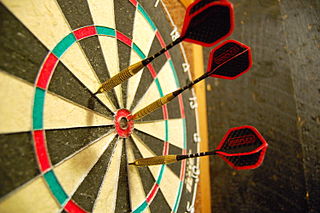
Darts or dart-throwing is a competitive sport in which two or more players bare-handedly throw small sharp-pointed projectiles known as darts at a round target known as a dartboard.
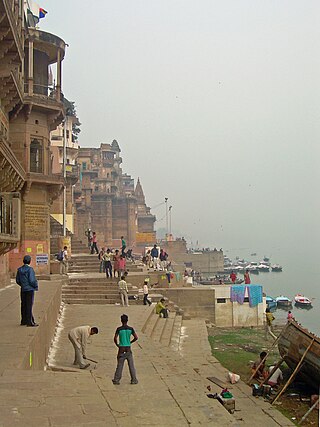
Gilli Danda is an ancient sport originating from South Asia, which is still widely played throughout South Asia. The sport is also found as far north as the Mediterranean and as far east as South East Asia. It was a precursor to cricket in South Asia.

Capture the Flag (CTF) is a traditional outdoor sport where two or more teams each have a flag and the objective is to capture the other team's flag, located at the team's "base", and bring it safely back to their own base. Enemy players can be "tagged" by players when out of their home territory and, depending on the rules, they may be out of the game, become members of the opposite team, be sent back to their own territory, be frozen in place, or be sent to "jail" until freed by a member of their own team.

A face-off is the method used to begin and restart play after goals in some sports using sticks, primarily ice hockey, bandy, floorball, broomball, rinkball, and lacrosse.

Ice stock sport is a winter sport, somewhat similar to curling. In German, it is known as Eisstockschießen. Although the sport is traditionally played on an ice surface, events are also held on tarmac in summer.
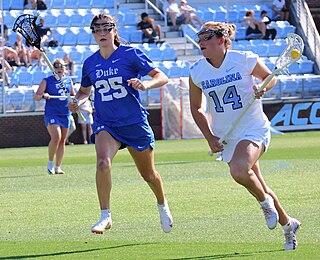
Women's lacrosse, sometimes shortened to lax, is a field sport played at the international level with two opposing teams of ten players each. Originally played by indigenous peoples of the Americas, the modern women's game was introduced in 1890 at the St Leonard's School in St Andrews, Scotland. The rules of women's lacrosse differ significantly from men's field lacrosse. The two are often considered to be different sports with a common root.

A baseball field, also called a ball field or baseball diamond, is the field upon which the game of baseball is played. The term can also be used as a metonym for a baseball park. The term sandlot is sometimes used, although this usually refers to less organized venues for activities like sandlot ball.

Mumblety-peg is an old outdoor game played using pocketknives. The term "mumblety-peg" came from the practice of putting a peg of about 2 to 3 in into the ground. The loser of the game had to take it out with his teeth. When the loser would go to remove the peg, it would sound as if they were mumbling.

Roller hockey, rink hockey or quad hockey is a team sport played on roller skates. It is a quad-skate team sport where two teams face-off against one another, trying to drive a hard ball with their sticks into the opposing teams' goalnet. Each team has five players on the rink at a time, four of whom are skaters and one who is the goalkeeper. The ball can only be put in motion by a stick, not the skate, otherwise a foul will be stated. The game has two 25-minute halves, with 15-minute halftime intermission, plus up to two 5-minute golden goal periods to settle ties with the clock stopping when the ball becomes dead. If the tie persists, a penalty shootout will determine the winner. Players – including the goalie – use quad skates, whereas inline skates are used in inline hockey. The sticks are similar to those in bandy and shinty. Excessive contact between players is forbidden in rink hockey, unlike inline hockey.
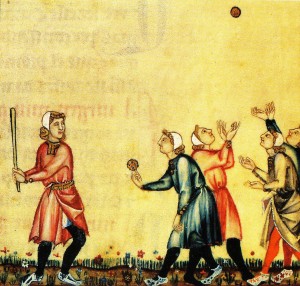
Bat-and-ball games are field games played by two opposing teams. Action starts when the defending team throws a ball at a dedicated player of the attacking team, who tries to hit it with a bat and run between various safe areas in the field to score runs (points). The defending team can use the ball in various ways against the attacking team's players to force them off the field when they are not in safe zones, and thus prevent them from further scoring. The best known modern bat-and-ball games are cricket and baseball, with common roots in the 18th-century games played in England.
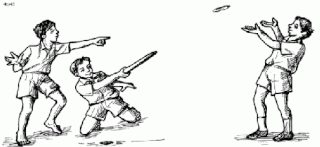
Dandi biyo is a game played in Nepal which was considered the de facto national game until 23 May 2017, when volleyball was declared as the national sport. Dandi biyo is played with a stick (dandi) about 2 feet (61 cm) long and a wooden pin (biyo) about 6 inches (15 cm) long. The pin is a small wooden stick with pointed ends. The game is similar to the Indian game gilli danda. The government has not implemented any policies for the preservation of dandi biyo, and with decreasing players the game is expected to be extinct soon.

Pelota mixteca is a team sport similar to a net-less tennis game. The players wear sturdy, elaborately decorated gloves affixed to a heavy flat striking surface, using them to strike a small solid ball. The game has roots extending back hundreds, or perhaps thousands, of years.
Jereed is a traditional Turkish equestrian team sport played outdoors on horseback in which the objective is to score points by throwing a blunt wooden javelin at opposing team's horsemen. Played by Turkic peoples in Central Asia as the essential sporting and ceremonial game, it was brought to Anatolia during the westward migration in the beginning of the 11th century.
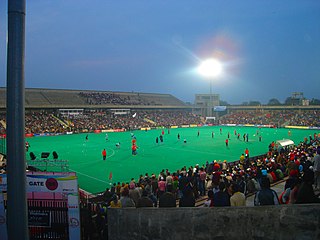
Punjabis play a wide variety of sports and games, ranging from modern games such as hockey and cricket, to the more traditional games such as Kabaddi, Kushtian (wrestling) and Khuddo khoondi. There are over 100 traditional games and sports of Punjab.
Cuba has several traditional games.
Mexico has some traditional games and activities.
References
- ↑ "Juegos Tradicionales Mayas | Yucatan Today". yucatantoday.com. Retrieved 2016-12-07.
- ↑ "FEDERACIOacute;N MEXICANA DE JUEGOS Y DEPORTES AUTOacute;CTONOS Y TRADICIONALES, A.C." www.jcarlosmacias.com. Retrieved 2016-12-07.
- ↑ "Kimbomba | Tocatì". tocati.it. Retrieved 2016-12-07.
- ↑ "Juegos Yucatecos". costumbres2.galeon.com. Retrieved 2016-12-07.
- ↑ "Juegos Tradicionales Mayas | Yucatan Today". yucatantoday.com. Retrieved 2016-12-07.
- ↑ "Uchben baxaloob - Tradiciones de mi región". sites.google.com. Retrieved 2016-12-07.
- ↑ "La Billarda - (Juegos Tradicionales Canarios)". www.isladetenerifevivela.com. Retrieved 2016-12-07.